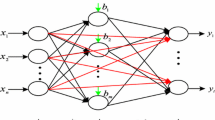Abstract
Compared with traditional neural networks, extreme learning machine (ELM) shows outstanding performances on speed and computation. Aiming at the problems that ELM needs more hidden layer neurons and meaningful features of data sometimes are sacrificed in order to improve the training speed, a novelty network multi-parallel extreme learning machine with excitatory and inhibitory neurons (MEI-ELM) is proposed based on the idea of biological neurons. In MEI-ELM, (1) A parallel system is introduced to make it more compact and reduce the number of hidden layer neurons. (2) The property of excitatory and inhibitory of biological neuronal for data processing is introduced to improve its performance. Through applying MEI-ELM, ELM, Fast Learning Network (FLN) and Fast Learning Network with Parallel Layer Perceptrons (PLP-FLN) to 11 classical regression problems, it can be obtained that MEI-ELM performs much better than the other methods in generalization and stability.






Similar content being viewed by others
References
Seifert Jeffrey W (2004) Data mining: an overview. In: World engineering congress
Green M, Ekelund U, Edenbrandt L et al (2009) Exploring new possibilities for case-based explanation of artificial neural network ensembles. Neural Netw 22:75–81
May RJ, Maier HR, Dandy GC (2010) Data splitting for artificial neural networks using SOM-based stratified sampling. Neural Netw Off J Int Neural Netw Soc 23:283–294
Bin LI, Yi-Bin LI (2011) Chaotic time series prediction based on ELM learning algorithm. Tianjin Daxue Xuebao 44:701–704
Huang GB, Zhu QY, Siew CK (2006) Extreme learning machine: theory and applications. Neurocomputing 70:489–501
Li MB, Meng JE (2006) Nonlinear system identification using extreme learning machine. In: 9th International conference on control, automation, robotics and vision, 2006. ICARCV’06. IEEE, pp 1–4
Suresh S, Babu RV, Kim HJ (2009) No-reference image quality assessment using modified extreme learning machine classifier. Appl Soft Comput 9:541–552
Rong HJ, Huang GB, Sundararajan N et al (2009) Online sequential fuzzy extreme learning machine for function approximation and classification problems. IEEE Trans Syst Man Cybern B Cybern A Publ IEEE Syst Man Cybern Soc 39:1067–1072
Han F, Huang DS (2006) Improved extreme learning machine for function approximation by encoding a priori information. Neurocomputing 69:2369–2373
Rong HJ, Ong YS, Tan AH et al (2008) A fast pruned-extreme learning machine for classification problem. Neurocomputing 72:359–366
Huang GB, Chen L (2008) Enhanced random search based incremental extreme learning machine. Neurocomptuing 71:3460–3468
Huang G, Song SJ, Gupta JND, Wu C (2014) Semi-supervised and unsupervised extreme learning machines. IEEE Trans Cybern 44(12):2405–2417
Jie Z, Wendong X, Yanjiao L et al (2018) Residual compensation extreme learning machine for regression. Neurocomputing 311:126–136
Lv F, Han M (2019) Hyperspectral image classification based on multiple reduced kernel extreme learning machine. Int J Mach Learn Cybern 6:1–9
Feixiang Zhao ID, Liu Y, Huo K et al (2018) Radar HRRP target recognition based on stacked autoencoder and extreme learning machine. Sensors 18(1):173
Khatab ZE, Hajihoseini A, Ghorashi SA (2018) A fingerprint method for indoor localization using autoencoder based deep extreme learning machine. IEEE Sens Lett 2(1):1–4
Li G, Niu P, Duan X et al (2013) Fast learning network: a novel artificial neural network with a fast learning speed. Neural Comput Appl 24:1683–1695
Caminhas WM, Vieira DAG, Vasconcelos JA (2003) Parallel layer perceptron. Neurocomputing 55:771–778
Li G et al (2017) Fast learning network with parallel layer perceptrons. Neural Process Lett 47:549–564
Caminhas WM, Vieira DAG, Vasconcelos JA (2003) Parallel layer perceptron. Neurocomputing 55:771–778
Uchizono K (1965) Characteristics of excitatory and inhibitory synapses in the central nervous system of the cat. Nature 207(4997):642–643
Wilson HR, Cowan JD (1972) Excitatory and inhibitory interactions in localized populations of model neurons. Biophys J 12(1):1–24
Billeh Yazan N, Schaub MT (2018) Feedforward architectures driven by inhibitory interactions. J Comput Neurosci 44(18):63–74
Yao Mingchen, Li W, Liu Y (2011) Double parallel extreme learning machine. Energy Procedia 13:7413–7418
Corinto F et al (2011) Synchronization in networks of FitzHugh–Nagumo neurons with memristor synapses. In: European conference on circuit theory and design IEEE
Gerard R (1941) The interaction of neurones. Ohio J 41:160–172
Acknowledgements
Project supported by the National Natural Science Foundation of China (Grant No. 61403331), Program for the Top Young Talents of Higher Learning Institutions of Hebei (Grant No. BJ2017033), Natural Science Foundation of Hebei Province (Grant No. F2016203427), China Postdoctoral Science Foundation (Grant No. 2015M571280)
Author information
Authors and Affiliations
Corresponding author
Additional information
Publisher's Note
Springer Nature remains neutral with regard to jurisdictional claims in published maps and institutional affiliations.
Rights and permissions
About this article
Cite this article
Li, G., Zou, J. Multi-parallel Extreme Learning Machine with Excitatory and Inhibitory Neurons for Regression. Neural Process Lett 51, 1579–1597 (2020). https://doi.org/10.1007/s11063-019-10160-3
Published:
Issue Date:
DOI: https://doi.org/10.1007/s11063-019-10160-3




